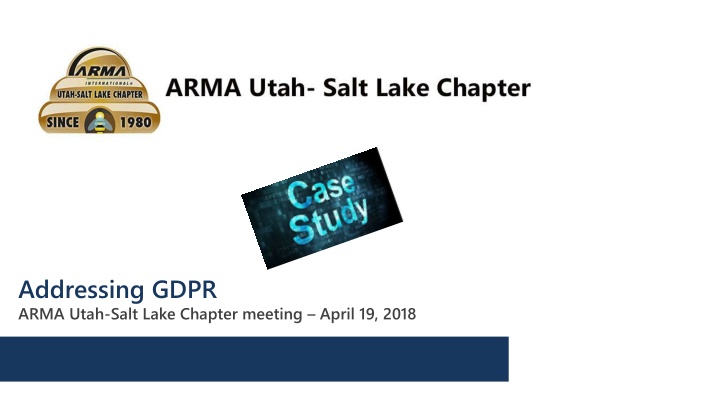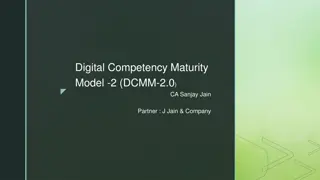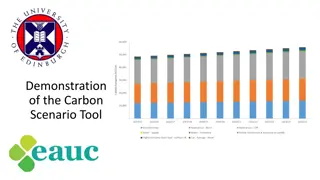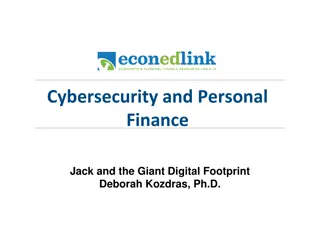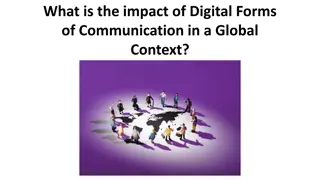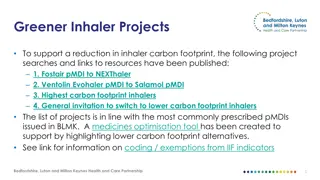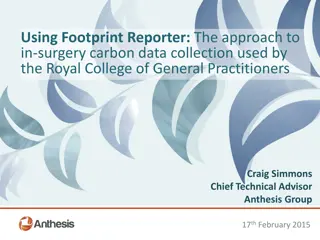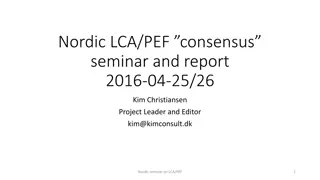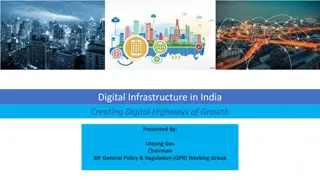My Digital Footprint and Future Implications
Your digital footprint is the trail of data you leave behind online, impacting your future endeavors like job opportunities and personal reputation. Being aware of your digital presence is crucial as it can have lasting consequences, both professionally and personally. Safeguarding your digital footprint involves managing your online activities and maintaining a positive online reputation. Understanding digital permanence is key to realizing that everything you do online is potentially permanent and can influence how others perceive you. Take control of your digital footprint to shape a favorable online image and secure your future prospects.
Download Presentation

Please find below an Image/Link to download the presentation.
The content on the website is provided AS IS for your information and personal use only. It may not be sold, licensed, or shared on other websites without obtaining consent from the author.If you encounter any issues during the download, it is possible that the publisher has removed the file from their server.
You are allowed to download the files provided on this website for personal or commercial use, subject to the condition that they are used lawfully. All files are the property of their respective owners.
The content on the website is provided AS IS for your information and personal use only. It may not be sold, licensed, or shared on other websites without obtaining consent from the author.
E N D
Presentation Transcript
Addressing GDPR ARMA Utah-Salt Lake Chapter meeting April 19, 2018
Agenda 1. What is GDPR? 2. Does it apply to my organization? 3. What should my organization do? 4. How does this impact Records Management? 5. What is BYU doing about GDPR?
What is GDPR GDPR is a data protection law (legislative act/regulation) with a goal to unify data protection law across the 28 member states of the European Union. This law replaced the Data Protection Directive of 1995 with expanded reach and improved protection and regulation to keep pace with modern technology.
What is GDPR GDPR is a personal privacy law for the EU that will apply to any company regardless of location that offers goods or services to EU citizens. Approved April 14, 2016 Enforced: May 25, 2018 Does GDPR Apply to Your Organization? Case Study- It applies to personal information we hold about students and perspective students, as well as financial documents or personal information we may hold of parents of students who are EU citizens.
Why GDPR? To address the digital age (e.g. Internet of Things, cyber crime) Vast increase in data and it s value EU to US Safe Harbor didn t work US Privacy is a consumer right EU sees privacy as a fundamental human right
Why do we care? Article 3 Territorial Scope. Any organization, regardless of size, that control or process the personal data of data subjects in the EU. (regardless of where the processing takes place) Any organization that offers goods or services to EU citizens GDPR applies to organizations if they: Have an establishment in the EU Have no establishment in the EU, but offer good and services to EU citizens Monitor the behavior of EU citizens (behavior takes place within the EU (includes internet tracking for retargeting and analysis)
Impact to RIM Retention matters- how long to store collected information: The information being collected from EU citizens Consent information New records will be created to document processing activity Need to know where impacted records reside, to respond to information requests Reporting structure where should RIM report to? Case Study: RIM is part of a larger IG initiative, including IT, Legal, Information Security and Data Privacy.
Major Features/Enhancements of GDPR Territorial Reach Privacy by Design Enhanced Individual Rights Expanded Definition of Personal Data Consent Breach Notification Data Controllers and Data Processors Organizational Requirements Penalties
Territorial Reach (who is protected) GDPR applies directly to any entity that processes personal data about EU residents in connection with the offering of good and services or monitoring the behavior of the EU Applies to Data Subjects as Natural Individuals who are in the EU Covers EU Citizens and Nationals, even when data is collected while outside the EU Cover non-EU individuals whose data is collected while in an EU Country (i.e., foreign students, ambassadors, immigrants, asylum seekers, refugees, vacationers and migrant workers) Covers any individual whose personal data is collected while in the EU, even if their Personal Data is processed elsewhere
Privacy by Design Ensure privacy from the very beginning of system design
Enhanced Individual Rights Requires data controllers to provide greater transparency about the data being collected and how that data will be used. Expanded rights include the: Right to deletion and correction Right to be forgotten Right to launch complaint Right to receive data being collected about them in a usable, common, machine language
Expanded Definition of Personal Data Personal Data Under the GDPR - Any information relating to an individual data subject who can be identified directly or indirectly by reference to an identifier such as name, identification number, geolocation data, online identifiers. Personal Data now includes: Unique online identifiers IP address Pixel tracking on web browsers User names and passwords Email address Mobile device identifiers such as geo location Biometrics finger prints, retina scans and genetic data Physical, physiological, genetic, mental, economic, cultural or social identity
Consent Must be specific to each data processing operation Easy to see Clear and plain language Provide in an intelligent and accessible form
Breach Notification Within 72 hours. Shorter than anything we now have in the US. Notification requirements to the supervisory authority and affected data subjects, within 72 hours of discovery of the breach.
Data Controllers and Data Processors Data processors will be required to maintain records of personal data and processing activities and will be subject to greater liability if responsible for a breach Data controllers cannot push liability onto processors. Must ensure contracts require processors to comply with GDPR
Organizational Requirements Data protection policy Maintain record of data processing activities Risk assessments Thought process of risk and how to mitigate it
Penalties GDPR is a regulation and not a recommendation Some could fall into 10 Million Euros or 2% of global revenue. Max is 20 Million or 4% of global revenue, whichever is higher.
GDPR - Basic Principles Data privacy is a fundamental right There must be a lawful basis for all data processing (e.g., consent, necessary to perform a contract, required by low, legitimate interests balanced against impact on individuals Special laws for processing special categories of personal data (sensitive information) concerning: racial or ethnic origin, political opinions, religious or philosophical beliefs, trade union memberships, genetics or biometrics, health, sexual orientation, criminal record Can only collect personal when required by law or have consent
Case Study: Impact of GDPR Own branch campus or study center in the EU Sending students to counterparts in the EU (exchange, research, internship, study abroad) Collaboration with EU institutions Online learning platforms Research incorporating EU data sets Soliciting student applications from EU Recruiting faculty from the EU Receiving donations from the EU Alumni data of EU citizens
Principles for Processing Information Process information lawfully, fairly and in a transparent manner to the individual Purpose Limitation data is collected for legitimate purposes and is disclosed up front Data limitation limited to what is necessary in relation to the stated purposes for which it was collected Accuracy must be accurate, corrected where necessary Storage kept for only as long as necessary for stated purpose Security kept in a secure manner Accountability Take steps to show you are putting in appropriate controls to protect the information
Processing of Personal Data Personal data any information used to identify a person, such as: name, id number, location data, online identifiers Processing: any operation or set of operations which is performed on personal data or sets of data Case Study: It s not just about securing PII. Anything in the student s record would apply, if linked to the student
When can you process personal data? Must have a legal basis to process personal data: With Consent When Necessary
With Consent Consent can be revoked at any time If revoked, need to cease processing data For example, click Agree on website, then later revoke your consent
When Necessary When necessary (don t generally need consent, unless sensitive data is collected) To perform, or enter into a contract with data subject Comply with a legal obligation To protect vital interests of data subject or another person For the performance of a task carried out in public interest For legitimate interests pursued by the controller or third-party, except when such interests are overridden by the interests or rights of the data subject.
What does Consent look like? Requires some clear, affirmative, demonstrable action Silence, pre-checked boxes or inactivity will not constitute consent Data controller must maintain some form of record regarding how and when consent was given Need retain a record of how and when the consent was given. How long does this need to be retained? What does the record look like? Cannot be permanently binding Data subject must be given the right to withdraw consent at any time Must be informed of this right before giving consent
What does Consent look like? Cannot condition the performance of the contract based on giving consent Request for consent must be presented clearly and in plain language distinguishable from other matters Cannot obtain blanket consent for multiple processes (application process and other purposes)
Right to be Informed Who can data subject contact for information? Who is the data controller s representative or who is the Data Protection Officer? What is the purpose of and legal basis for processing the information? What are the categories of personal data being collected? Who are the recipients of the data? What is the source of personal data, if not obtained directly from individual? Will the data be transferred to third countries and what safeguards will be in place? (Access is considered a transfer, even if not physically moved) Retention. How long will the data be retained? Existence of their right to withdraw consent Right to submit complaint to regulatory authority Consequences for failing to provide required data Are you engaging in automated decision making
Right to be Forgotten Data subjects have a right to request that you destroy records you have of them, along with personal data Must erase data and prevent processing in certain circumstances and a individual s request (Article 17) May conflict with: State FOI laws Federal/state retention requirements Internal policies Requirements for doing business
Data Breach Notification A breach of security leading to the accidental or unlawful destruction, loss, alteration, unauthorized disclosure of, or access to, personal data Notify supervisory authority oIf likely to result in a risk to individual rights and freedoms oWithin 72 hours (unless law enforcement requests delay)
Data Breach Notification Notify individual (data subject) oIf likely to result in high risk to individual rights and freedoms oWithout undue delay oSupervisory authority may instruct controller to notify individuals. Exceptions: Unlikely to result in high risk Appropriate technical and organizational protection was in place (e.g., encryption) Would involve disproportionate efforts
Data Breach Notification Notify data controller oAll breaches oWithout undue delay after becoming aware of breach Information in breach notification oNature of the records and approximate number and categories of individuals data affected oContact information for data protection officer and other contact points oLikely consequences of breach oMeasures taken or to be taken to mitigate the breach The controller must document: othe facts related to the breach oThe effects of the breach oThe remedial measures taken
Boiling it all down What to do Determine if and how GDPR impacts your organization. If so Hire a Data Privacy Officer & create data Privacy Policy Address processes & records of highest risk first Collecting EU data and Sensitive Data Provide notifications and obtain consent (active not passive) Document procedures for processing EU data Identify where this data is being stored and how long to keep it Create retention policies to address consent and other impacted records Create data destruction procedures to address the Right to be Forgotten Expand data breach protocols and incident response plans
Some Implementation Considerations The lifecycle of the data could be affected by the need for data subjects to provide consent for the set of operations you are going to conduct to process that data What are we going to do to collect this kind of consent? Do we treat affected information as an exception? At what point do we make these processes mandatory for everyone to achieve economies of scale in our processing? How and when do we obtain consent
RIM Opportunities and Challenges Working with related areas to identify records and advise on retention issues Change reporting structure What records can be forgotten and what must be retained Addressing legacy records No notifications or disclosures No consent was given How do we respond to requests to view/correct data? Do we have a legitimate reason to keep it?
Thank You/Questions Howard Loos, CRM, IGP University Records and Information Management Brigham Young University Howard.Loos@byu.edu 801-422-2161 RecordsManagement.byu.edu
